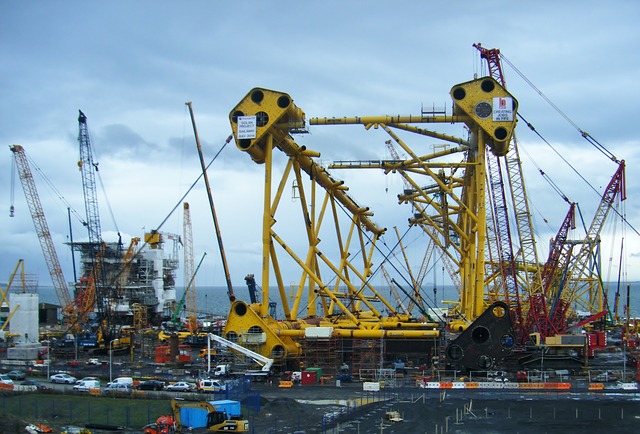WelderDestiny › Welding Jobs › Structural Welder Jobs
Structural Welder Jobs
We define a structural Welder as a person that performs field construction and maintenance welding to significant structures. Typically these would be bridges, steel framed high rise buildings and oil and gas platforms. We will also look at being a structural Welder within a dedicated structural steel fabrication workshop. To get more information about being a Welder within a welding fabricator workshop, click here.
The WelderDestiny Compass: Weekly e-zine Subscription
You can take a look at "The WelderDestiny Compass" back-issues by clicking here.
When
constructing major structural steel structures, there are a number of drivers
that need to be met at the same time. These are:
- Normally large volumes of weld metal need to be deposited for the main structural welds.
- Tight schedules are normally associated with the construction of these structures.
- Welding needs to be of medium to high integrity, depending on the weld being done, and the structure being constructed. This means that in some cases the welds will be subjected to high levels of Non Destructive Testing. (NDT)
- Due to the field welding conditions, the environment can often be quite challenging for the structural Welder. (Think windy conditions high up on a scaffold or on the side of a building or oil rig.)
- As the structures may be subjected to extreme design conditions, the welding procedures are to be closely followed, to ensure that the correct properties are achieved. Typically such extreme conditions may be earthquake loads, extreme storm loads under arctic conditions or loads due to cyclones in tropical regions.
- While a lot of the welding may be to large "primary" structures, there will also be a lot of more minor welding of attachments.
- On many modern structures, more advanced high strength steels are used to allow higher stresses and therefore lower material requirements leading to lower costs.
 Oil Platform Jacket Under Construction
Oil Platform Jacket Under ConstructionMaterials Typically Welded
Most
of the time, ordinary structural carbon steels will be used in large structures. These can vary in their strength category, with the higher strength
steels needing more care when welding, to ensure that Hydrogen Assisted Cold
Cracking (HACC) does not occur. Click here
to find out more about HACC and preventing it when welding. There are some
other materials that are welded, but they tend to be a relatively small
percentage of the over-all structural work. These materials include stainless
steel and weathering steel. As these are only a small percentage of the overall
structural welding work, we will not look at that aspect further on this page.
Typical Structural Welder Skills
Due
to the need to deposit a lot of weld metal in a short period of time, welding
processes with a high deposition rate is often used by a structural Welder. In addition,
welding processes generally need to be low hydrogen, to ensure that HACC does
not occur.
The
main welding processes / techniques that the structural Welder needs to be able
to use are:
- Flux Cored Arc Welding: (FCAW) Semi-automatic FCAW has high deposition rates while allowing the flexibility to weld in all positions and to gain access to relatively difficult to access areas. For more protected areas, welding with a gas shield is preferred due to the better weld quality and higher deposition rates. For more exposed areas, the self shielded version of FCAW is preferred. The structural Welder will therefore need to make sure that s/he can weld with both these variants of the FCAW process.
- Shielded Metal Arc Welding: (SMAW) Also called stick welding or Manual Metal Arc. (MMA) The main use of SMAW is for smaller attachment welds, and to perform the root runs of single sided welds where it is not possible to have backing present. Generally this is done with E7016 electrodes, but it may be required of you to be able to deposit single sided root runs using other Low Hydrogen (LH) electrodes. For example, these days a 1% Nickel electrode is quite common due to the improved impact properties, especially under lower temperatures.
- Submerged Arc Welding: (SAW) This is primarily a machine process, so it is not really suitable for field welding conditions, but is the process of choice in workshop environments where large structural components with relatively simple weld preparations are to be welded. Typically cylindrical "cans" or fabricated columns or beams. If you will be working primarily outside in a field construction environment, then SAW would not be required.
- Gas Metal Arc Welding: (GMAW) Also called Metal Inert Gas (MIG) or Metal Active Gas (MAG) welding. The main problems with GMAW are that it needs a gas shield and can quite easily result in Lack Of Fusion (LOF) defects when welding out of position. (Out of position welding refers to a situation where the Welder needs to deposit a weld which is not horizontal, hence resulting in gravity having a negative effect on the weld pool.) For this reason, GMAW is normally only used in a workshop environment and on relatively light weight structures. It is generally avoided on heavy structural applications where out of position welding is required.
Due
to the heavy sections typically welded, the application of pre-heat before
welding is a very important aspect. It will therefore be very important for the
prospective structural Welder to get a good grasp of the different pre-heating
techniques and equipment that will be used. Most of the time, if it is required
of the Welder to apply his/her own pre-heat, then it will be by way of propane
torch or some variant of a propane fired heating system. When the more
"exotic" systems such as resistance heating or induction heating are
used, then dedicated personnel are normally hired to operate the equipment.
WelderDestiny › Welding Jobs › Structural Welder Jobs
The WelderDestiny Compass: Weekly e-zine Subscription
You can take a look at "The WelderDestiny Compass" back-issues by clicking here.